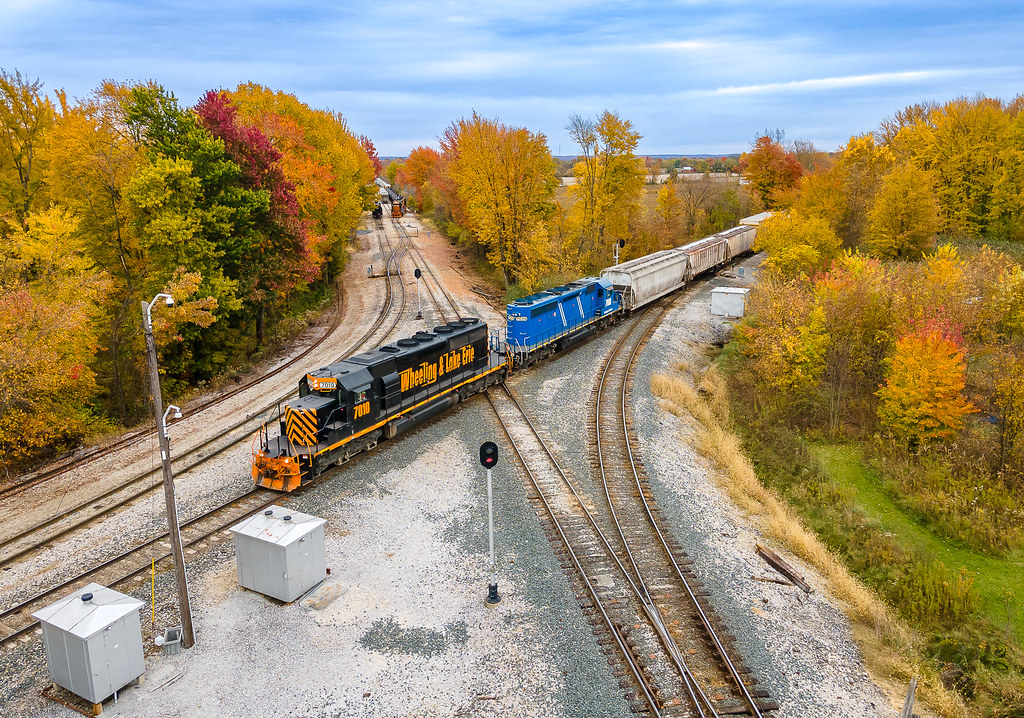#emd sd40-2
Text

BCOL 4609 and CN 5381 cross a trestle bridge over the Sturgeon River in St. Albert, Alberta, with graffitied train cars in tow, 04/07/2022. Photo by Rob Eull via Railpictures.ca
BC Rail’s GE Dash 8-40CM locomotives entered the CN roster when BC Rail’s freight operations were leased to CN in 2004. Some were repainted with CN livery, but many remained in service with their original paint jobs. BCOL 4609 is the only one in active operation today, and indeed the last 8-40CM on CN’s roster.
#alberta#canadian national#bc rail#ge dash 8-40cm#emd sd40-2#trains#love u bcol 4609 u go old girl#last of her kind and still leading trains :’)
1 note
·
View note
Photo
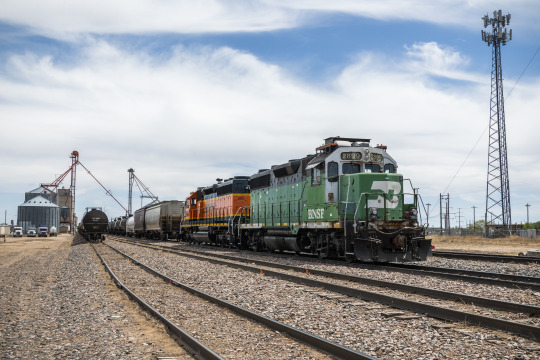
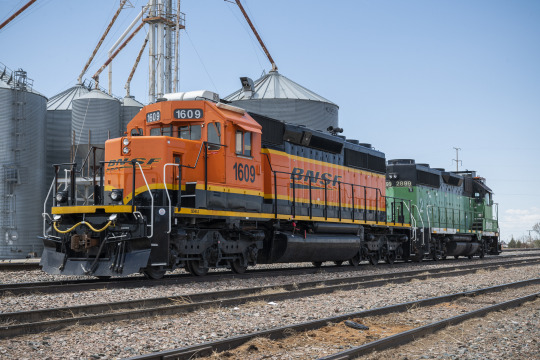
Generations
Here’s a couple more shots from Dalhart, Texas—two aging EMD units, of the first and second generations, built in La Grange, Illinois. The locomotives rest along the former Colorado & Southern Railway.
Burlington Northern 2899 was built as a GP35 in 1965 while BNSF 1609 is an SD40-2 from 1979.
Two images by Richard Koenig; taken April 27th 2023.
#railroadhistory#railwayhistory#dalhart#dalharttexas#dalharttx#emd#gp35#sd40-2#c&s#colorado&southern#burlingtonnorthern#bn#bnsf
42 notes
·
View notes
Video
Bicentennial Display by NAPM Model Railroad Club
Via Flickr:
Eight locomotives in bicentennial liveries assemble for a special event in NAPM's Ottawa yard in 1975. This photo was inspired by an iconic prototype photo taken by Trains magazine at the Belt Railway of Chicago's 87th Street yard; it was taken during a special NAPM photo session featuring 22 member-owned bicentennial locomotives. Photo by Mark Mathu. Visit the HO scale NAPM club on-line at www.napmltd.org.
#SD45-2#SD45#GP38-2#MP15#diesel#locomotive#SD40T-2#EMD#SD40#SD#SSW#MP15DC#scenery#yard#GTW#GP#BN#NAPM#road name#_Mark Mathu#SD40-2#GP38#Burlington Northern#GT#Grand Trunk#Grand Trunk Western#HO#Milwaukee#North American Prototype Modelers#Saint Louis Southwestern
19 notes
·
View notes
Video
Return to Harrington by Erie Limited
Via Flickr:
DCR 3502 arrives at Harrington, DE with a long cut of tank cars in the consist. I believe this was HA-1 returning to town. The building at right, which now serves as DCR's office, was once Pennsylvania Railroad's Harrington passenger depot. DCR 3502 SD40-3
4 notes
·
View notes
Video
Summer Blossoms in the Land of Iron by Nomad of Mid-America
Via Flickr:
Vivid carpets of northern Minnesota wildflowers form an vibrant foreground at Burnett, MN, for Canadian National train U71581 17, Minntac limestone loads rolling north towards the Iron Range on the Missabe Sub behind 4 proud examples of EMD muscle still exemplifying their top-notch versatility, the most junior of the foursome only one year shy of a half-century of service.
#train#railroad#locomotive#cn#canadian#national#dmir#duluth#missabe#iron#range#404#emd#sd40-3#sd45t-2#burnett#mn#minnesota#wildflower#flower#sd40u#tunnel motor
3 notes
·
View notes
Text

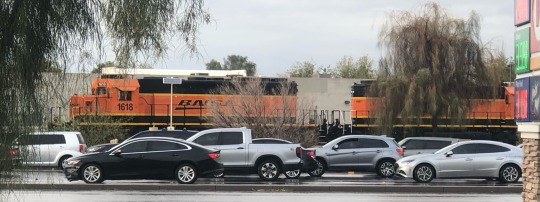
Spotted bnsf locos 1667 & 1618 (both SD40-2s) double-heading a short freight train through El Mirage, Arizona. The last couple cars were empty bulkhead flatcars, which leads me to believe they were bringing an empty train back to the yard after dropping off their freight.
#trainspotting#trainspotter#bnsf#Burlington northern and Santa Fe railway#emd#electro-motive diesel#sd40-2
0 notes
Video
Grinding around Breezy Point by Mike Danneman
Via Flickr:
Four Burlington Northern GE C30-7s pull hard on a PSCX coal train rounding Breezy Point west of Belmont, Nebraska, on the climb over Crawford Hill on July 7, 1996. In the background on the other side of the horseshoe curve is the end of the train and a helper set of three EMD SD40-2 and a fuel tender.
#bnsf#burlington northern santa fe#bn#burlington northern#1996#trains#freight train#history#belmont#nebraska
182 notes
·
View notes
Text
A month ago, I made a post showing all my OCs from the Great Northern Railway. Now this post will go over my OCs from the…

Now these engines make up BNSF’s Santa Fe heritage fleet…

and can only be found on railroad territories that were previously owned and operated by the Atchison, Topeka and Santa Fe Railway… or as it was more commonly known; the Santa Fe Railway. And these engines are…

Blue Jay, the 4-6-4 #3460

Blackberry, the 4-6-4 #3450

Bigwig, the 4-6-4 #3464
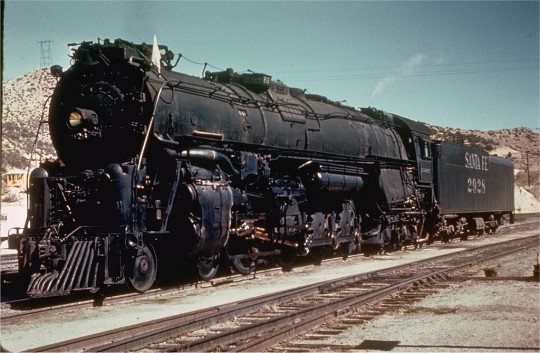
Fiver, the 4-8-4 #2928

Chief, the 4-8-4 #2926

Mara, the 2-10-2 #3960
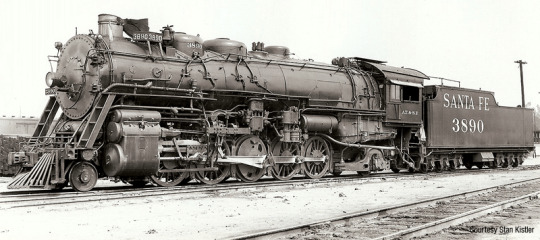
Dukey, the 2-10-2 #3890

Hazel, the 2-10-2 #3864

Gladion, the ALCO PA-1 #51

Clair, the ALCO PA-1 #62

Snitter, the ALCO PA-1 #52
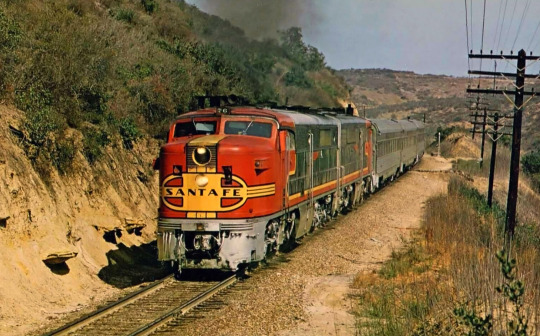
Haywood, the ALCO PA-1 #76 and San Diegan engine

Rudolph, the EMD F7 #306

Harley, the EMD F7 #32 and El Capitan engine

Hoskins, the EMD F7 #24 and Super Chief engine
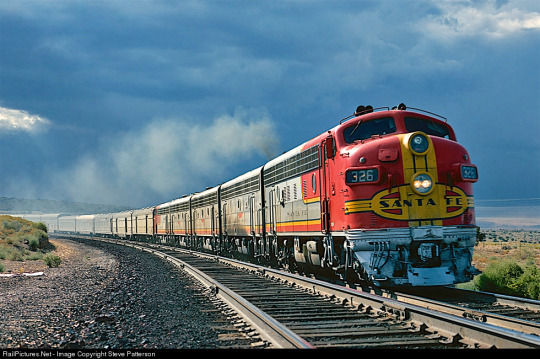
Angeles, the EMD F7 #326 and San Francisco Chief engine

Dapper Jack, the EMD F7 #338 and Texas Chief engine

Ami, the EMD F7 #330

Ivy, the GE C44-9W #600
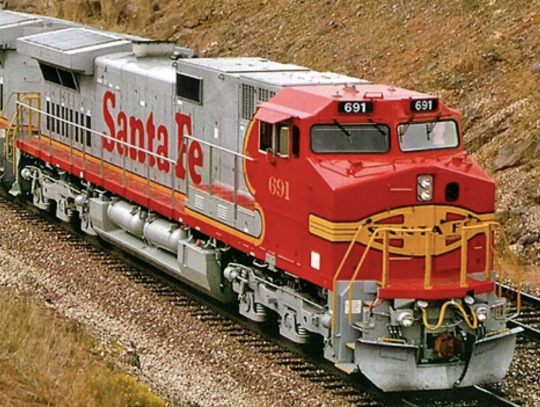
Carly, the GE C44-9W #691

Harvey, the EMD SD40-2 #5024

Cali, the EMD SD40-2 #5114
#santa fe#atsf#steam locomotive#steam engine#diesel locomotive#diesel engine#passenger train#passenger cars#freight cars#freight train#train#trains#railroad#railroads#railway#railways#rail#rails#thomas and friends#thomas the tank engine#ttte#ttte oc#locomotive#genie team
19 notes
·
View notes
Video
Wheeling & Lake Erie Railway WLE 7010 (EMD SD40-2) WLE Train: 221 Spencer, Ohio por Terry Redeker
8 notes
·
View notes
Note
Who is tower? :O
Tower is like if you took a catgirl, but the "cat" was actually "barely-domesticated tiger." She's technically an Autobot, but boi it does NOT feel like it. She's a kind of "might makes right" character, bullying and badgering with any authority she thinks she can get away with. She's got a particularly sadistic streak around Decepticons, less so because they're "the bad guys" and moreso because she knows that's how other peeps see them and she can get away with actually flexing her might around them. (looong ass post below)
She's a train, specifically the EMD SD40-2 (because they run around here locally and holy shit, they're really big. I tend to lock Tower's height around 50ft (ignoring how stupid this is to do in any transformers continuity)(because her altmode is ~68 ft long and like, 15ft high I barely come up over the wheels), which, for tfa (I base most of my tf writing around tfa, but it tendssss to soup at points), makes her on the upper end of Decepticon heights, much less Autobots. I like to headcannon that since she's a train, an alt that runs on pre-set tracks that would have already been tested for things like weight, Tower and other train-bots are on the heavier end of cybertronians, with beefier engines and able to store more fuel, instead of having to worry about things like taking off and not sinking into the ground. This does come back to bite her in the ass though.

Tower doesn't have any ranged weapons. She does a shield she can create by pressing her knuckles together and generally does pretty well against ranged weapons. She can also break falls with it, as it just deflects any force applied to it, but it does have its own stress limits and can't usually be active for longer than a minute.
She doesn't... really know how to use her own strength. If she'd been properly trained to fight, she's be trying to wrestle them into submission, pin them in and the like. Instead she hits hard and fast... like a train. She lacks stamina fighting like this, and ends up wasting her energy on a lot of missed strikes.
I call her a catgirl because she behaves a lot like a cat. Toying with opponents, generally being smug and annoying, making horrible noises with her wheels (I've heard the trains around here make some wild noises), sometimes using uwu-speak (I would apologize, but its too late to actually mean it at this point), and couple visual traits I've given her to make her look like one (It's actually why I don't have a humanformers version of her, I just don't know how to make her face look right nothing's worked).
She doesn't have much in the way of friends, given she doesn't really ever get emotionally close to others, or even displays a wide emotional range. It's always some state of joy, amused or trying to look like she's not about to put her fists in someone's face. It's hard for her to come off as genuine in her emotions, and it's hard for her to get close. Not made better by the fact she won't actively try and instead just spends most of her time laying around (like a cat).
In general, a mean, smug bully who meows at you before you kiss a wall.
2 notes
·
View notes
Text

"Under code blue skies and on home rails, M-CHIGAL (Hodgkins, IL - Galesburg, IL) heads west for work in Joliet Yard with BNSF 167 (GP60) in original Santa Fe Blue Bonnet colors, trailing is 3 BNSF H4 EMDs of a GP38-2, SD40-2, and a SD60M. Seen here at the classic spot of Lemont, IL, crossing the 124 year old former swing bridge over the Chicago Sanitary & Ship Canal on the BNSF Chillicothe Sub."
Lemont, Illinois
May 7, 2022
Photo by James Bradley
66 notes
·
View notes
Text

A CP freight train led by four locomotives (CP 8000-7046-5792-5973) climbs through the rubble at the site of the Frank Slide in Alberta, 06/29/2022. Photo by Rob Eull via Railpictures.ca
In the early morning of April 29, 1903, the largest recorded landslide in Canadian history buried part of the town of Frank, Alberta under 110 million tons of limestone. The rockslide obstructed 1.2 miles of CP's mainline; it took three weeks for the railway to blast a path back through the debris field.
1 note
·
View note
Text
Freight run 4 2day: Union Pacific Yermo to Colton, two EMD DDA40X Centennials with one EMD SD40-2 pulling 40 TOFCs.
1 note
·
View note
Photo

Day 23: EMD SDP40F
Info from Wikipedia:
The EMD SDP40F was a six-axle 3,000 hp (2.2 MW) C-C diesel–electric locomotive built by General Motors Electro-Motive Division (EMD) from 1973–1974. EMD built 150 for Amtrak, the operator of most intercity passenger trains in the United States. Amtrak, a private company but funded by the United States government, had begun operation in 1971 with a fleet of aging diesel locomotives inherited from various private railroads. The SDP40F was the first diesel locomotive built new for Amtrak and for a brief time they formed the backbone of the company's long-distance fleet.
A series of derailments in the mid-1970s shattered Amtrak's confidence in the locomotive, and many railroads banned it from their tracks. Multiple investigations pointed to issues with the locomotive's trucks, the weight of the water and steam generators used for train heating, or the harmonic vibration of baggage cars behind the locomotive. In 1977 Amtrak decided to move on from the SDP40F in favor of the EMD F40PH, which was already in use on short-distance routes. Amtrak traded most of its fleet into EMD; the components were incorporated into new F40PHs. The remainder were traded to the Atchison, Topeka and Santa Fe Railway (ATSF) for use in freight service. The Santa Fe rebuilt the locomotives and designated them SDF40-2. The Burlington Northern Santa Fe Railway (BNSF), successor to the Santa Fe, retired them in 2002. One of them is preserved.
Amtrak assumed operation of most intercity rail passenger service in the United States on May 1, 1971. Until then such services were operated by various private railroads. The private railroads chose to retain their second generation passenger locomotives for freight service, or to operate the various commuter services which, by law, did not pass to Amtrak. To operate these intercity services the Amtrak had to buy or lease from the private railroads whatever locomotives remained. This left Amtrak with an aging and mechanically-incompatible fleet of diesel locomotives. The mainstays of Amtrak's road diesel fleet were veteran E units and F units, which were 10–20 years old and due for replacement.
The SDP40F was a full-width cowl unit. It was based on the EMD FP45 passenger locomotive and EMD SD40-2 freight locomotive. All three shared the EMD 645E3 diesel prime mover, which developed 3,000 hp (2.2 MW). The locomotive had a gear ratio of 57:20. Maximum speed at full horsepower was 94 mph (151.3 km/h); the locomotive exceeded 100 miles per hour (160.9 km/h) in tests. There were doubts at the time about Amtrak's long-term viability, so the locomotives were designed for easy conversion to freight locomotives should Amtrak cease operation.
In the early 1970s Amtrak's passenger car fleet was steam-heated; Amtrak's requirement called for two steam generators. These were located at the rear of the locomotive. Forward of the generators was a 1,350-US-gallon (5,110.3 l; 1,124.1 imp gal) water tank. This tank rested above the floorline. The lateral motion of the water within was later implicated in several derailments. The primary underbody tank was split between water and diesel fuel, carrying 2,150 US gallons (8,138.6 l; 1,790.2 imp gal) of water and 2,500 US gallons (9,463.5 l; 2,081.7 imp gal) of diesel. Provision was made for eventual conversion to head-end power (HEP), but it was never carried out.
EMD based the SDP40F name on the existing SDP40. Several years earlier, EMD had made similar versions of the SDP45 and SD45 in a full-width cowl unit, which it named FP45 and F45. Although the SDP40F was externally nearly identical to the FP45, EMD chose not to give the new locomotive a similar name such as FP40. EMD wanted to avoid adding a new locomotive type to their catalog due to price controls in effect in the early 1970s. The following year, the F40C name was used for a similar locomotive ordered by the Chicago, Milwaukee, St. Paul and Pacific Railroad (the "Milwaukee Road"), equipped with HEP instead of steam generators.
There were several minor differences between the first 40 locomotives built and later examples. The most important was the installation of lower-profile cooling fans and air horns to avoid clearance problems in the Eastern US.
Amtrak ordered 150 SDP40Fs, in two batches. The first order, placed on November 2, 1972, was for 40 locomotives, at a cost of $18 million. A second order, for 110 locomotives at $50 million, followed on October 12, 1973. These orders were Amtrak's first for new-build locomotives.[18] Amtrak deployed the original 40 locomotives on long-distance trains in the Western United States. The locomotives entered revenue service on June 22, 1973, hauling the Super Chief from Chicago to Los Angeles over the Atchison, Topeka and Santa Fe Railway. SDP40Fs were also used on the Burlington Northern Railroad. The arrival of the second order enabled Amtrak to deploy the SDP40Fs throughout the country, displacing the inherited E-units.
In late 1975 J. David Ingles called the SDP40Fs the "stars of Amtrak's long-distance trains," but engine crews reported that the locomotives rode poorly compared to the E-units they had replaced. Even as Amtrak and EMD investigated the ride quality, the SDP40F was involved in a series of derailments that would lead to an end to its career as a passenger locomotive. Between 1974–1976 the Federal Railroad Administration (FRA) identified thirteen incidents for which the locomotive was responsible. None of the incidents were serious, but their frequency was a concern. Most of the derailments occurred on trains with two SDP40Fs on the front and at least one trailing baggage car. While the rear truck of the second locomotive and the front truck of the baggage car were pinpointed as the source of the derailment, the actual cause of the derailments was unclear.
EMD, Amtrak, the Association of American Railroads (AAR), and the FRA tested the locomotive thoroughly, with suspicion falling on the "hollow bolster" truck design. In the end, the investigators theorized that the steam generators and water tank may have made the rear of the engine too heavy and created too much lateral motion. Later FRA investigations concluded that the actual culprit was the light weight of the baggage cars, which caused harmonic vibrations when placed directly behind the much heavier SDP40F. A contributing factor was the sometimes poor quality of track the locomotive operated over.
Amtrak took several corrective measures, including operating with a reduced speed on curves, emptying the smaller of the two water tanks to reduce lateral motion, and making various alterations to the trucks. The measures helped, but the trouble continued. Several railroads, including the Burlington and the Chesapeake and Ohio Railway (C&O), banned the "rail breakers" from their tracks (they were suspected or known to be causing the spreading of rails because of their lateral swaying, which may have contributed to the derailments)[citation needed]. For the Chicago–Seattle Empire Builder, the speed restrictions added 6 hours to what had been a 46-hour schedule. Another important development was the unusually harsh winter of 1976–1977, which sidelined many of Amtrak's aging steam-heated coaches. Amtrak suspended numerous routes and pressed the new HEP-equipped Amfleet I coaches, designed for short runs, into service. The new EMD F40PH, intended for short-distance service and equipped with HEP, handled these trains.
In the spring of 1977 Amtrak faced a power crisis. In addition to the SDP40Fs derailing, Amtrak was having trouble with two other six-axle designs. The GE E60CP and E60CH electric locomotives were having derailment problems. The GE P30CH had the same truck design as E60s and rode poorly, although it did not exhibit the same tendency to derail. Amtrak decided to abandon the SDP40F in favor of the F40PH, a four-axle design with none of the riding problems of the six-axle locomotives. Amtrak traded 40 SDP40Fs back to EMD. Components including the prime mover were installed into an F40PH's frame. Between 1977–1987 Amtrak traded 132 of the SDP40Fs back to EMD for F40PHRs. The SDP40F remained in service on the Santa Fe longer than elsewhere, although the arrival of HEP-equipped Superliner cars on the Western routes displaced them from there as well. The last SDP40Fs left the Amtrak roster in 1987. The remaining Amtrak SDP40F's that weren't sold to the ATSF (seen below) are presumed to have been scrapped.
In 1984 Amtrak, low on light-duty power, traded 18 SDP40Fs to the Santa Fe for 43 switchers: 25 CF7s and 18 SSB1200s. Santa Fe rebuilt the traded locomotives for freight use. Modifications included removing the steam generators and regearing for lower speed. The locomotives were also given front steps and platforms, and notched noses in order to improve boarding access. The rebuilt locomotives were designated SDF40-2. The SDF40-2s continued in service with the BNSF Railway, successor to the Santa Fe, until their retirement in 2002.
One SDF40-2, ex-Amtrak No. 644, was acquired by Dynamic Rail Preservation Inc. and is in Boulder City, Nevada having been previously displayed in Ogden, Utah. It has been renumbered to its Santa Fe-era 6976 number and returned to operation in November 2019.
models and route by: American Trainz Group, trainzman54, Auran, and Download Station
#EMD#EMD SDP40F#Amtrak SDP40F#SDP40F#Amtrak#Diesel Locomotive#Trainz Simulator#Trains#Advent Calendar#Christmas#Christmas 2022 🎄🎅🎁
2 notes
·
View notes
Photo

BNSF Railway 170 was built by EMD as a GP60B (ATSF 347), but was rebuilt with a cab (donated from Union Pacific SD40-2 3751) into a "regular" GP60. The unit is seen here at Mid America Car in Kansas City, Missouri, having just been painted into full BNSF colors. Photo by Craig Walker
6 notes
·
View notes
Note
The SD40-2 was introduced in January 1972 as part of EMD's Dash 2 series, competing against the GE U30C and the ALCO Century 630. Although higher-horsepower locomotives were available, including EMD's own SD45-2, the reliability and versatility of the 3,000-horsepower (2,200 kW) SD40-2 made it one of the best-selling models in EMD's history, edged only by the GP9, and the standard of the industry for several decades after its introduction. The SD40-2 was an improvement over the SD40, with modular electronic control systems similar to those of the experimental DDA40X.
Peak production of the SD40-2 was in the mid-1970s. Sales of the SD40-2 began to diminish after 1981 due to the oil crisis, increased competition from GE's Dash-7 series and the introduction of the EMD SD50, which was available concurrently to late SD40-2 production. The last SD40-2 delivered to a United States railroad was built in July 1984, with production continuing for railroads in Canada until 1988, Mexico until February 1986, and Brazil until October 1989.
The SD40-2 has seen service in Canada, Mexico, Brazil and Guinea. To suit export country specifications, General Motors designed the JT26CW-SS (British Rail Class 59) for Great Britain, the GT26CW-2 for Yugoslavia, South Korea, Iran, Morocco, Peru and Pakistan, while the GT26CU-2 went to Zimbabwe and Brazil. Various customizations led Algeria to receive their version of a SD40-2, known as GT26HCW-2.
very interesting. thank you for this information.
2 notes
·
View notes

